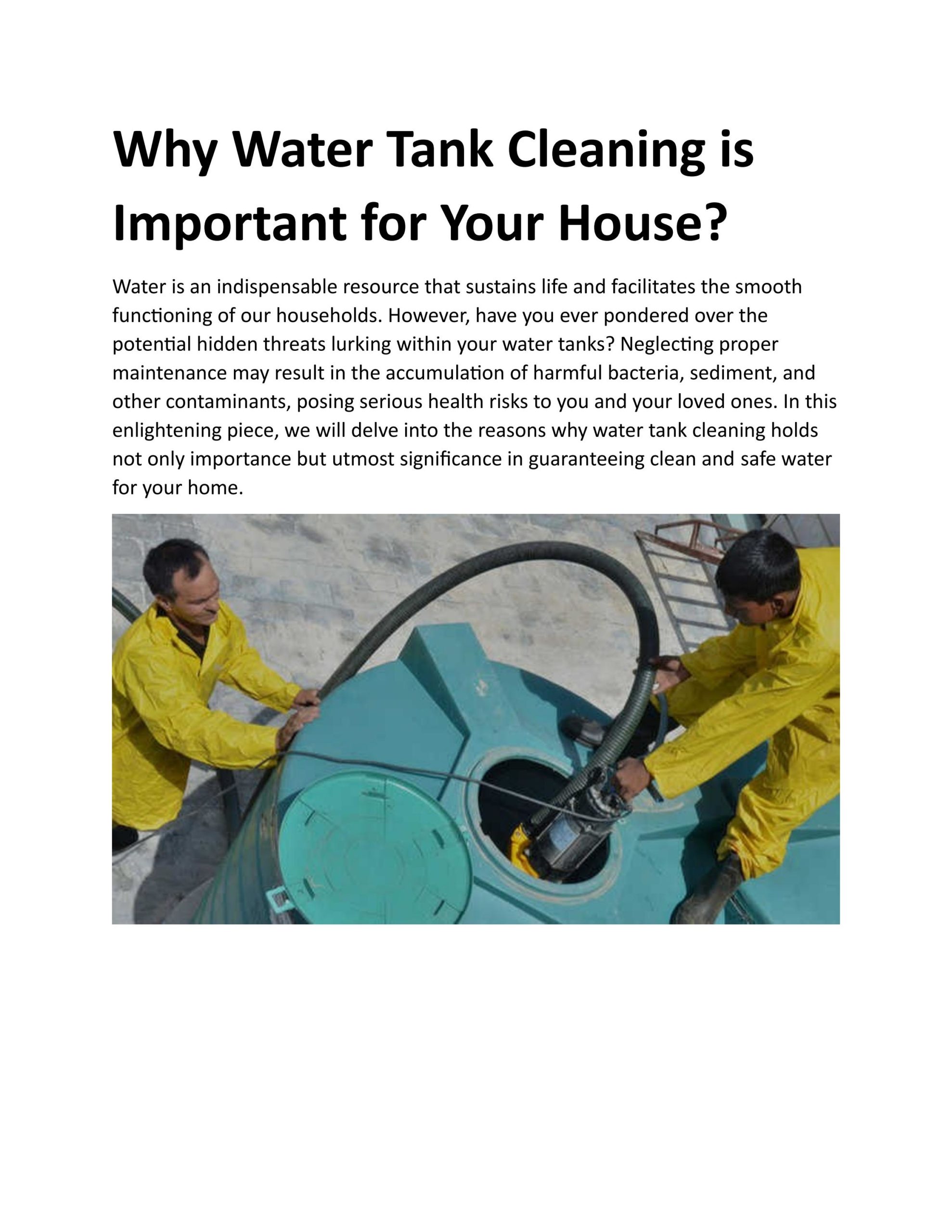Regular water tank cleaning is crucial for maintaining the health and safety of individuals. Contaminated water can harbor harmful bacteria, viruses, and other microorganisms that pose serious health risks when consumed or used for daily activities. By regularly cleaning water tanks, you can ensure that the water you and your loved ones use is free from these harmful contaminants. In addition to health benefits, regular cleaning also helps to maintain the structural integrity of the tank, preventing corrosion and prolonging its lifespan. So, don’t overlook the importance of regular water tank cleaning for the sake of your health and safety.
Understanding the Importance of Water Tank Cleaning
Water tanks play a vital role in providing clean and safe water for our daily needs. Whether it’s for domestic use or commercial purposes, these tanks store and supply water for various activities such as drinking, cooking, bathing, and washing. However, it is crucial to understand the importance of regular water tank cleaning to maintain the quality and safety of the water supply.
The role of water tanks
Water tanks act as a reservoir, storing water from different sources such as wells, rivers, or municipal supplies. They ensure a continuous and reliable water supply, especially in areas where water scarcity is a concern. These tanks typically have a filtration system to remove impurities and contaminants, ensuring that the water is safe for consumption and other uses. However, over time, these impurities can accumulate in the tanks and compromise the quality of the water.
Why cleaning is necessary
Regular cleaning of water tanks is necessary to remove any accumulated sediments, debris, and contaminants that can infiltrate the water supply. Without proper cleaning and maintenance, microbial growth, including bacteria and viruses, can thrive in the tank, posing significant health risks to individuals who consume or use the water. Additionally, neglecting water tank cleaning can lead to decreased water quality, pipe corrosion, and wastage of water – all of which can have negative consequences for both human health and the environment.
Health Risks Associated with Dirty Water Tanks
Dirty water tanks can harbor various health risks due to the accumulation of bacteria, viruses, and other contaminants. It is essential to be aware of these risks to understand the importance of regular water tank cleaning.
Potential bacteria and viruses
When water tanks are not cleaned regularly, bacteria such as E. coli, Salmonella, and Legionella can thrive and multiply in the stagnant water. These bacteria can cause severe illnesses, including gastrointestinal infections and respiratory diseases, when ingested or inhaled. Similarly, viruses like Hepatitis A and Norovirus can contaminate the water supply and lead to outbreaks of diseases.
Waterborne diseases
Neglected water tanks can become breeding grounds for waterborne diseases such as cholera, dysentery, typhoid, and giardiasis. These diseases are caused by various pathogens that contaminate the water, and they can spread rapidly if the water is consumed without adequate treatment.
Risk on immune-compromised individuals
Individuals with compromised immune systems, such as the elderly, young children, pregnant women, and those with certain medical conditions, are particularly vulnerable to the health risks associated with dirty water tanks. Their weakened immune systems make them more susceptible to infections and diseases caused by the contaminants present in the water.
Effects of Negligence on Water Tank Maintenance
Negligence in maintaining water tanks can have several negative effects on the overall water quality and the functionality of the tank system. It is important to understand these effects to realize the significance of regular tank maintenance.
Decreased water quality
As sediments and contaminants accumulate in the water tank, the overall quality of the stored water decreases. The water may become turbid, have an unpleasant odor, or have an off-putting taste. Consuming or using water of poor quality can have adverse effects on health and may lead to gastrointestinal issues, skin problems, and other related complications.
Pipe corrosion
The presence of sediment and corrosive elements in the water can lead to pipe corrosion within the tank system. Corrosion not only compromises the structural integrity of the pipes but also contaminates the water supply with rust, heavy metals, and other harmful substances. Corroded pipes can also result in leaks, leading to further water wastage and potential damage to the surrounding infrastructure.
Water wastage
Neglected water tanks can develop leaks, cracks, or other forms of structural damage over time. These issues can result in water leakage, leading to significant wastage of this precious resource. Water wastage not only has environmental implications but also adds to the financial burden of replacing or repairing damaged tanks and pipes.
Water Tank Contamination: Common Sources and Causes
Understanding the common sources and causes of water tank contamination is crucial in implementing preventive measures and ensuring the safety of the water supply.
Environmental factors
Environmental factors such as dust, dirt, leaves, bird droppings, and other debris can find their way into open water tanks. Rainwater can also introduce contaminants if the tank lacks proper covers or filters. These external factors contribute to the accumulation of sediments and the growth of bacteria and other microorganisms within the tank.
Irregular cleaning and maintenance
The lack of regular cleaning and maintenance is a significant cause of water tank contamination. Over time, sediments, algae, and biofilm can form within the tank, creating an environment that promotes the growth of bacteria and viruses. Without routine cleaning, these contaminants can multiply and affect the water quality.
Poor tank material or construction
The material and construction of the water tank can also contribute to contamination if they are substandard or lack proper design features. For example, tanks made from low-quality materials may release harmful chemicals into the water, compromising its safety. Similarly, tanks that do not have adequate ventilation or proper drainage systems may provide an environment conducive to bacterial growth and contamination.

Understanding the Water Tank Cleaning Process
The water tank cleaning process involves several steps to ensure a thorough and effective cleaning. Understanding these steps is essential for proper maintenance and hygiene.
Initial assessment
Before starting the cleaning process, it is crucial to conduct an initial assessment of the tank’s condition. This includes checking for any visible signs of contamination, damage, or leaks. The assessment will help determine the extent of cleaning required and any necessary repairs or replacements.
Draining and cleaning
The first step in the cleaning process is emptying the tank. This can be done by pumping out the water or using other draining methods. After the tank is empty, it needs to be thoroughly cleaned using appropriate cleaning agents, brushes, and equipment. The aim is to remove any sediments, sludge, biofilm, or dirt that may have accumulated on the tank walls, floor, and other surfaces.
Disinfection
Once the tank is clean, it needs to be disinfected to kill any remaining microorganisms and sanitize the tank. Chlorine or other disinfectants are commonly used for this purpose. It is crucial to follow the recommended dosage and contact time to ensure effective disinfection without leaving any harmful residues.
Post-cleaning check
After disinfection, the tank should be thoroughly rinsed with clean water to remove any traces of the cleaning agents or disinfectants. A post-cleaning check should be conducted to ensure that the tank is free from contaminants and ready to be refilled with clean and safe water.
Role of Professionals in Water Tank Cleaning
While individuals can attempt to clean their water tanks themselves, hiring professionals for the job offers several advantages.
Expertise and knowledge
Water tank cleaning professionals have the necessary expertise and knowledge to perform the task efficiently and effectively. They are trained in identifying and addressing various tank-related issues while ensuring the safety and quality of the water supply. Their experience in handling different types of tanks and contaminants contributes to a thorough and reliable cleaning process.
Use of specialized tools and solutions
Water tank cleaning professionals use specialized tools, equipment, and cleaning solutions that are specifically designed for tank cleaning. These tools and solutions enable them to reach inaccessible areas and remove stubborn sediments and contaminants effectively. By using the right equipment and solutions, professionals can ensure a more thorough cleaning compared to DIY methods.
Safety assurance
Cleaning water tanks can be a risky task, especially if the tanks are large, located at heights, or require extensive cleaning and repairs. Professionals are trained to perform the job safely, minimizing the risk of accidents, injuries, or further damage to the tank or surrounding infrastructure. Hiring professionals provides peace of mind, knowing that the cleaning process is handled with the necessary precautions and safety measures.

DIY Water Tank Cleaning: Pros and Cons
While professional assistance is recommended for water tank cleaning, some individuals may choose the DIY route. It is important to weigh the pros and cons before deciding to clean the tank on your own.
Cost-saving measures
One of the significant advantages of DIY water tank cleaning is the potential cost savings. By eliminating the need to hire professionals, individuals can save money on service fees. DIY cleaning methods often involve household cleaning agents and basic tools, which are typically more affordable than specialized cleaning equipment.
Potential risks
DIY water tank cleaning poses several potential risks. Without adequate knowledge and experience, individuals may overlook critical aspects of the cleaning process, leading to ineffective or incomplete cleaning. Inadequate disinfection or improper rinsing can leave behind harmful residues or traces of contaminants. The handling of cleaning chemicals and exposure to microbial growth within the tank can also pose health risks if not done with caution.
Skills and effort required
Cleaning a water tank requires physical effort and specific skills to ensure thorough cleaning and maintenance. DIY enthusiasts need to be prepared for the time-consuming task of draining the tank, scrubbing the surfaces, and handling cleaning agents properly. The process may also require individuals to access tight spaces, climb ladders, or work in challenging environments, which may not be feasible for everyone.
How Often Should Water Tanks be Cleaned
The frequency of water tank cleaning depends on several factors. Understanding these factors will help determine how often you should clean your water tank.
Determining factors
The determining factors for tank cleaning frequency include the size of the tank, the quality of the water source, the level of usage, and the environmental conditions. Larger tanks tend to accumulate sediments and contaminants at a slower rate compared to smaller tanks. If the water source is prone to contamination or the tank is used frequently, more frequent cleaning may be necessary. Similarly, tanks in areas with high dust or pollutant levels may require more frequent cleaning to maintain water quality.
Standard recommendation
As a general guideline, it is recommended to clean domestic water tanks at least once a year. However, this recommendation may vary depending on the factors mentioned above. Commercial or industrial water tanks may require more regular cleaning, depending on their usage and specific industry requirements. Consulting with professionals or following any specific guidelines provided by the tank manufacturer is essential to determine the appropriate cleaning schedule.
Signs that your water tank needs cleaning
It is crucial to be vigilant for any signs that indicate the need for water tank cleaning. Changes in the color, odor, or taste of the water are clear indications of contamination. Sediments or floating particles in the water also suggest the presence of impurities. Other signs may include decreased water pressure, frequent plumbing issues, or sudden waterborne illnesses among users. Regular inspections and monitoring of the water supply can help identify these signs and prompt the necessary cleaning actions.
Improving Water Tank Safety: Preventive Measures
Taking preventive measures can significantly contribute to the safety and longevity of water tanks. Implementing the following measures can help maintain a clean and reliable water supply.
Regular inspections
Regular inspections of water tanks can help identify any signs of damage, contamination, or other issues. It is advisable to inspect the tank at least once every six months or more frequently if specific environmental or usage factors apply. Inspections should include checking for leaks, cracks, growing algae, sediment buildup, and any unusual odors or discoloration. Prompt action can be taken if any concerns are identified during the inspection.
Use of water tank covers
Using water tank covers is an effective way to prevent external contaminants from entering the tank. Covers protect the tank’s opening from dust, debris, insects, and bird droppings. Mesh or perforated covers allow for ventilation while still preventing larger particles from entering the tank. It is important to ensure that the covers are securely fitted to avoid any gaps that may compromise their effectiveness.
Proper tank location and installation
The location and installation of water tanks can greatly impact their safety and maintenance. Tanks should be placed in well-ventilated areas away from sources of contamination such as sewage systems, chemical storage areas, or livestock facilities. Adequate space should be provided around the tank for easy access and maintenance. Installation should be done by professionals to ensure proper alignment, secure connections, and compliance with building codes and regulations.
Advocating for Health and Safety through Regular Water Tank Cleaning
Raising awareness about the importance of regular water tank cleaning is essential for promoting public health and safety. Various stakeholders, including government bodies, home and business owners, and water utility providers, play a role in advocating for these practices.
Raising public awareness
Education and awareness campaigns can inform the public about the risks associated with neglected water tanks and the benefits of regular cleaning and maintenance. Providing information on the potential health hazards, emphasizing the importance of clean water, and offering guidance on proper tank cleaning procedures can empower individuals to take action and prioritize the cleanliness of their water supply.
Government health policies and regulations
Government health departments and regulatory bodies play a vital role in enforcing health policies and regulations related to water tank cleanliness. Setting standards for tank maintenance, providing guidelines for inspections and cleaning, and conducting regular assessments of public water supplies ensure the provision of safe and clean drinking water. Collaboration between government agencies, health departments, and water utility providers is necessary to monitor, regulate, and enforce these policies effectively.
Role of home and business owners
Homeowners and business owners have a responsibility to prioritize water tank cleanliness and maintenance. By adhering to regular cleaning schedules, conducting inspections, and promptly addressing any issues, they can ensure the safety and quality of the water supply for themselves and their families or customers. Promoting a culture of cleanliness and hygiene in residential complexes, commercial establishments, and public spaces contributes to the overall health and well-being of the community.
In conclusion, understanding the importance of regular water tank cleaning is crucial for maintaining the health and safety of individuals and communities. Dirty water tanks pose significant health risks due to the potential presence of bacteria, viruses, and waterborne diseases. Neglected tanks can lead to decreased water quality, pipe corrosion, and wastage of water. Environmental factors, irregular cleaning and maintenance, and poor tank material or construction contribute to tank contamination. The water tank cleaning process involves initial assessment, draining and cleaning, disinfection, and a post-cleaning check. Professionals offer expertise, use specialized tools, and ensure safety in the cleaning process. DIY cleaning may save costs, but it comes with potential risks and requires specific skills and effort. The frequency of water tank cleaning depends on various factors, and preventive measures such as regular inspections, use of covers, and proper tank location and installation can improve water tank safety. Public awareness, government regulations, and the responsibility of home and business owners are essential in advocating for regular water tank cleaning and prioritizing health and safety. By understanding and implementing these measures, we can ensure clean and safe water for all.






